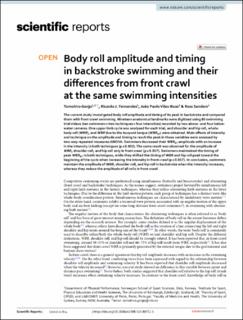| dc.contributor.author | Gonjo, Tomohiro | |
| dc.contributor.author | Fernandes, Ricardo J. | |
| dc.contributor.author | Vilas-Boas, João Paulo | |
| dc.contributor.author | Sanders, Ross | |
| dc.date.accessioned | 2022-03-21T15:27:01Z | |
| dc.date.available | 2022-03-21T15:27:01Z | |
| dc.date.created | 2021-01-12T13:39:25Z | |
| dc.date.issued | 2021 | |
| dc.identifier.citation | Scientific Reports. 2021, 11(2021), Artikkel 824. | en_US |
| dc.identifier.issn | 2045-2322 | |
| dc.identifier.uri | https://hdl.handle.net/11250/2986617 | |
| dc.description | This article is licensed under a Creative Commons Attribution 4.0 International License, which permits use, sharing, adaptation, distribution and reproduction in any medium or format, as long as you give appropriate credit to the original author(s) and the source, provide a link to the Creative Commons licence, and indicate if changes were made. The images or other third party material in this article are included in the article’s Creative Commons licence, unless indicated otherwise in a credit line to the material. If material is not included in the article’s Creative Commons licence and your intended use is not permitted by statutory regulation or exceeds the permitted use, you will need to obtain permission directly from the copyright holder. | en_US |
| dc.description.abstract | The current study investigated body roll amplitude and timing of its peak in backstroke and compared them with front crawl swimming. Nineteen anatomical landmarks were digitised using 80 swimming trial videos (ten swimmers × two techniques × four intensities) recorded by two above- and four below-water cameras. One upper-limb cycle was analysed for each trial, and shoulder and hip roll, whole-body roll (WBR), and WBR due to the buoyant torque (WBRBT) were obtained. Main effects of intensity and technique on the amplitude and timing to reach the peak in those variables were assessed by two-way repeated-measures ANOVA. Swimmers decreased their WBRBT amplitude with an increase in the intensity in both techniques (p ≤ 0.005). The same result was observed for the amplitude of WBR, shoulder roll, and hip roll only in front crawl (p ≤ 0.017). Swimmers maintained the timing of peak WBRBT in both techniques, while they shifted the timing of WBR and hip roll peak toward the beginning of the cycle when increasing the intensity in front crawl (p ≤ 0.017). In conclusion, swimmers maintain the amplitude of WBR, shoulder roll, and hip roll in backstroke when the intensity increases, whereas they reduce the amplitude of all rolls in front crawl. | en_US |
| dc.language.iso | eng | en_US |
| dc.subject | biomechanics | en_US |
| dc.subject | fluid dynamics | en_US |
| dc.subject | musculoskeletal system | en_US |
| dc.title | Body roll amplitude and timing in backstroke swimming and their differences from front crawl at the same swimming intensities | en_US |
| dc.type | Peer reviewed | en_US |
| dc.type | Journal article | en_US |
| dc.description.version | publishedVersion | en_US |
| dc.rights.holder | © The Author(s) 2021 | en_US |
| dc.source.pagenumber | 12 | en_US |
| dc.source.volume | 11 | en_US |
| dc.source.journal | Scientific Reports | en_US |
| dc.identifier.doi | 10.1038/s41598-020-80711-5 | |
| dc.identifier.cristin | 1869870 | |
| dc.description.localcode | Institutt for fysisk prestasjonsevne / Department of Physical Performance | en_US |
| dc.source.articlenumber | 824 | en_US |
| cristin.ispublished | true | |
| cristin.fulltext | original | |
| cristin.qualitycode | 1 | |
